This set of Electric Circuits Multiple Choice Questions & Answers (MCQs) focuses on “Source Transformations”.
1. By using source transformation voltage source in series resistor is replaced by __________
a) Voltage source in series with a resistor
b) Current source in parallel with a resistor
c) Voltage source in parallel with a resistor
d) Current source in series with a resistor
View Answer
Explanation: In Source transformation, a voltage source in series with a resistor is replaced by a current source in parallel with the same resistor and vice versa.
2. Source Transformation is _____________
a) Unilateral
b) Unique
c) Bilateral
d) Complicated
View Answer
Explanation: In Source transformation, a voltage source in series with a resistor is replaced by a current source in parallel with the same resistor and vice versa. So, it is bilateral.
3. If there are two resistors in parallel and in series with a voltage source then ___________
a) Parallel resistor has no effect
b) Series resistor has no effect
c) Both has their respective effects
d) Both has no effect on the voltage source
View Answer
Explanation: In source transformation, the voltage source in series with a resistor to be replaced by a current source in parallel with the same resistor and vice versa. So other resistors are redundant and have no effect.
4. Using source transformation, calculate the voltage.
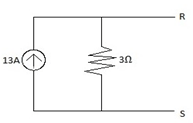
a) 4.33V
b) 39V
c) 0.230V
d) 36V
View Answer
Explanation: V=IR=13*3=39V.
5. Which element(s) has no effect in the given circuit?
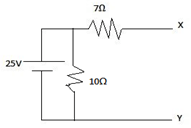
a) 7Ω
b) 10Ω
c) Both 7Ω and 10Ω
d) Voltage source.
View Answer
Explanation: Voltage in series with a resistor in replaced by a current source but here 10Ω is in parallel. So, it is redundant and has no effect.
6. The value of current source is __________ after replacing the given network with a single current source and a resistor.
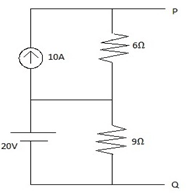
a) 70V
b) 60V
c) 90V
d) 80V
View Answer
Explanation: In the given circuit 9Ω resistor has no effect.
10*6=60V, 60V+20V=80V.
7. If there is a 12A current source in series with 2Ω and in parallel with a 4Ω resistor, then voltage V=?
a) 24V
b) 48V
c) 3V
d) 6V
View Answer
Explanation: 2Ω resistor is redundant. 12*4=48V.
8. Find the current flowing through 4Ω resistor shown in network below.
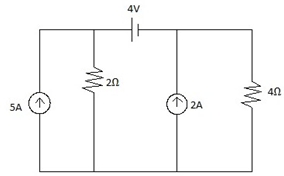
a) 1.33A
b) 2.35A
c) 1.66A
d) 2.66A
View Answer
Explanation: By using source transformation the above network is reduced and then by current division rule I4Ω= 5*(2/2+4) =1.66A.
9. Calculate the power delivered by the 50V source.
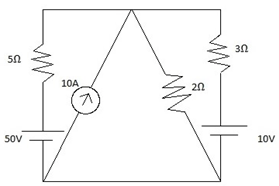
a) 274W
b) 276W
c) 285W
d) 291W
View Answer
Explanation: By using source transformation the above network is reduced and current in the circuit is found out and later power delivered by 50V source= 50*current in the circuit= 50*5.48A= 274W.
10. Source transformation can be used for dependent sources.
a) True
b) False
View Answer
Explanation: Source transformation can be used for dependent sources. However, the controlling variable must not be tampered with any way since the controlled source operation depends on it.
11. Using source transformation, calculate vm.
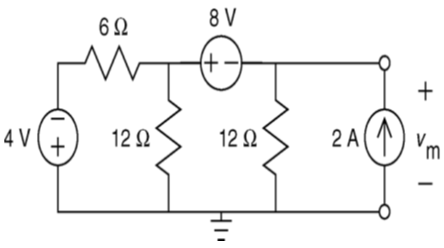
a) 2v
b) -2v
c) 1v
d) -1v
View Answer
Explanation: Using source transformation, the network is reduced and at last voltage is obtained.
12. Find the voltage value Vm in the circuit given below.
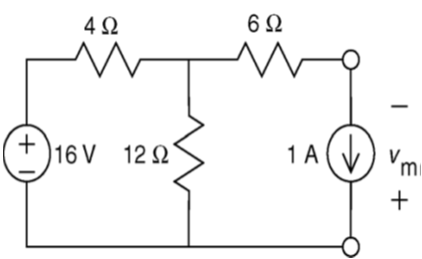
a) -3V
b) 3V
c) 2.1V
d) -2.1V
View Answer
Explanation: Using source transformation, the voltage source in series with a resistor to be replaced by a current source in parallel with the same resistor and vice versa.
13. Source transformation technique is mainly based on __________ law.
a) Newton’s
b) Kirchhoff’s
c) Ohm’s
d) Einstein’s
View Answer
Explanation: Ohm’s law: V=iR. By using this, the voltage/ current sources are reduced.
14. In source transformation,
a) Voltage sources remain same
b) Current sources remain same
c) Both voltage and current sources undergo change
d) Resistances/Impedances remain same
View Answer
Explanation: In source transformation, only the particular voltage/current sources change whereas the resistances remain same.
15. If there are five 20V voltage sources in parallel, then in source transformation __________
a) All are considered
b) Only one is considered
c) All are ignored
d) Only 2 are considered
View Answer
Explanation: In parallel, voltages are same. So, only is considered and rest are ignored.
Sanfoundry Global Education & Learning Series – Electric Circuits.
To practice all areas of Electric Circuits, here is complete set of 1000+ Multiple Choice Questions and Answers.
If you find a mistake in question / option / answer, kindly take a screenshot and email to [email protected]
- Apply for Electronics & Communication Engineering Internship
- Practice Electronics & Communication Engineering MCQs
- Practice Electrical Engineering MCQs
- Check Electric Circuits Books
- Apply for Electrical Engineering Internship
